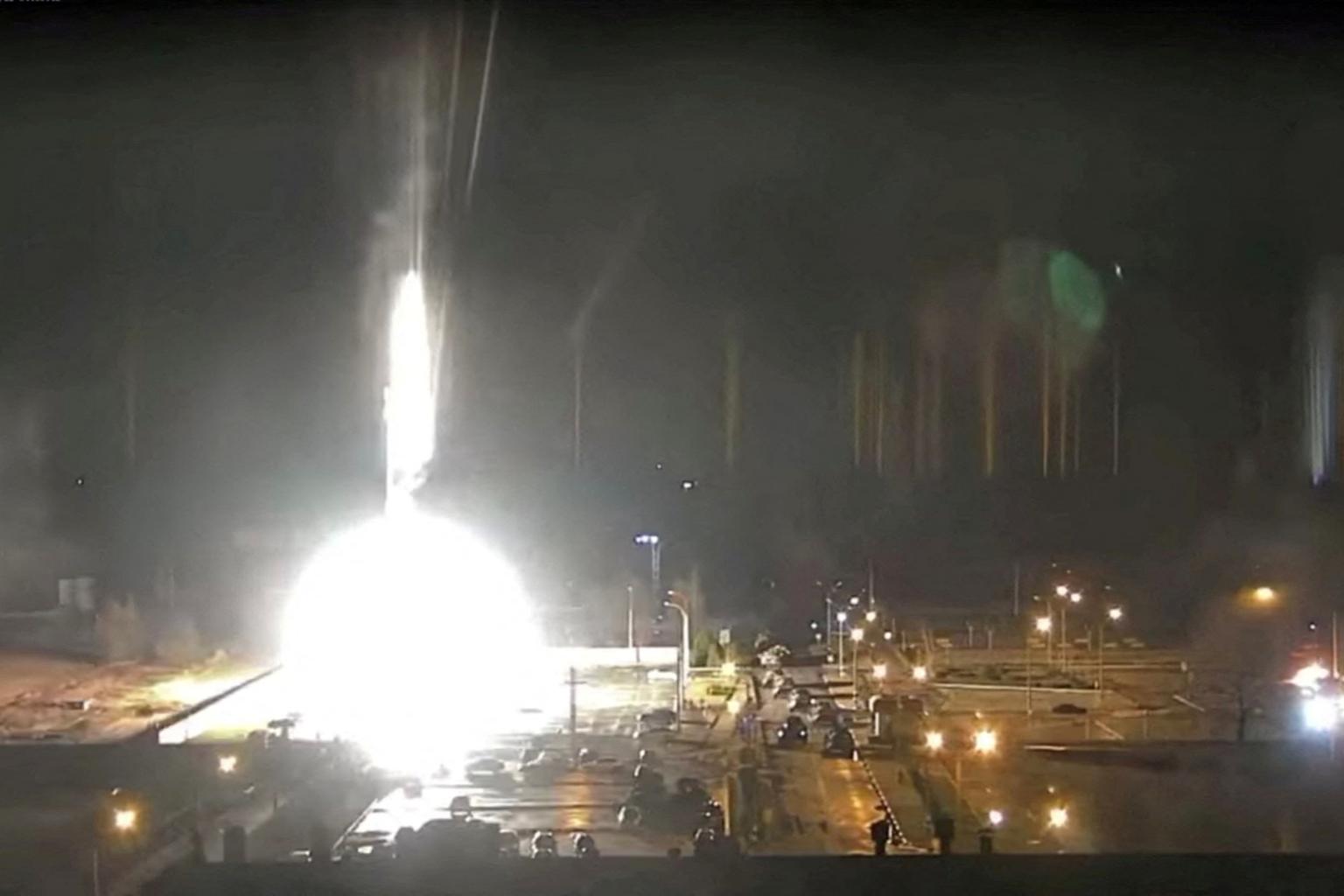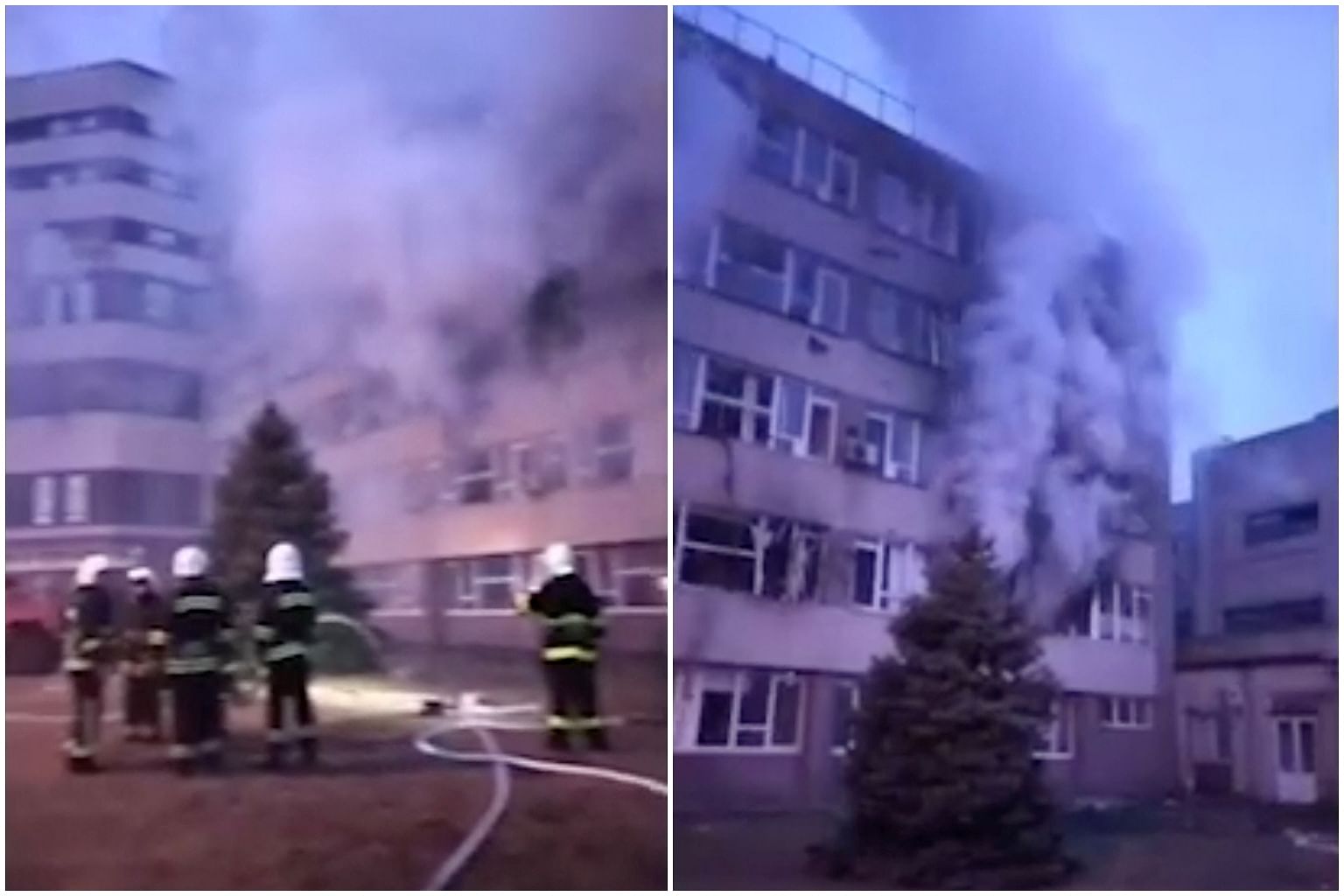Combat at Ukraine nuclear plant adds radioactive dangers to Russian invasion
Sign up now: Get ST's newsletters delivered to your inbox

Surveillance camera footage shows a flare landing at the Zaporizhzhia nuclear power plant in Ukraine on March 4, 2022.
PHOTO: ZAPORIZHZHYA NPP/REUTERS
Follow topic:
LVIV (NYTIMES) - In darkness, Russia captured Europe's largest nuclear power plant in Ukraine on Friday (March 4), prompting questions about the reasons it invaded the sprawling reactor site as well as the health risks to Ukrainians fighting desperately for their lives and freedom.
And it's not the only power plant in Ukraine that could face attack by Russian forces. Some troops already appear to be marching toward another facility west of the Zaporizhzhia power plant, a Ukrainian energy official said.
For the moment, the Zaporizhzhia nuclear complex appears safe, with the plant's array of sensitive detectors finding no releases of radioactivity above the usual background levels.
The vast site, on the Dnieper River roughly 160km north of Crimea, hosts not only six reactors whose cores are full of highly radioactive fuel but also many hectares of open ponds of water where spent fuel rods are submerged to cool off, typically for years.
Experts fear that an errant shell or missile might set off an environmental disaster and, if a fire broke out, release clouds of radioactive particles that get carried by the wind around Europe.
"The thing you worry about is an ignorant soldier who is scared and fires off a rocket or a mortar that causes a calamity," said David Albright, a physicist and president of the Institute for Science and International Security, a private group in Washington that tracks nuclear arms and material.
An accident of that nature could pose enormous dangers to Ukrainians and people in surrounding countries, including Russia.
"If you have a cloud with nuclear isotopes which can be formed in this accident at ZNPP, then only God knows where it will go," said Petro Kotin, acting president of Energoatom, the state company that runs Ukraine's nuclear energy facilities, referring to Zaporizhzhia.
All week, the website of the Zaporizhzhia complex had noted that the Ukrainian military unit 3042, which guards the complex, was "in combat readiness". When the Russian forces broke through, fighting resulted in exchanges of munitions and a fire, although it was contained to a training facility on the perimeter of the complex. Kotin said a Russian shell hit the No. 1 reactor, but its thick walls gave it the strength to survive the blow.
International observers and Ukrainian officials said that as of 6am (12pm Singapore time) on Friday, the complex was able to function safely. Kotin said that the Russian forces had allowed the nuclear plant's operations to continue at a normal pace since they took over the complex.
"The personnel itself is working normally in the unit, if we can say 'like normal'," said Kotin, who was the Zaporizhzhia facility's general manager and was closely involved in its construction before leading Energoatom.
Rafael Mariano Grossi, director general of the International Atomic Energy Agency, an arm of the United Nations that sets safety standards for the world's nuclear reactors, said on Friday that three of the site's six reactors had been shut down and that the remaining three were operating at less than full capacity.
Kotin said the Russian forces did not include nuclear energy specialists from Russia, only soldiers who were not familiar with the operations of a complex power facility. But the Russians had allowed one shift of workers to be replaced by another, which may be crucial to keeping the plant operating safely.
"The most dangerous thing for the plant is when people do not go on rotation," said Olena Pareniuk, a nuclear safety expert at the National Academy of Sciences of Ukraine. "They get tired. But to work at the nuclear plant is like to be a surgeon, it is important for people to be rested and not stressed to avoid mistakes."
Pareniuk said that living under military occupation would put a strain on the thousands of Ukrainians who work at Zaporizhzhia. Kotin warned of a humanitarian crisis in Enerhodar, which he said was cut off from deliveries of food and other supplies. He said that Russian soldiers were seizing food from the town's shops. The city was working to restore heat, water and electricity.
Should an accident occur in which the reactor fuel overheats and melts the reactor's core or shielding, Frank N. von Hippel, a physicist who advised the Clinton administration and now teaches at Princeton University, said it could be a repeat of the meltdowns that happened in 1979 at Three Mile Island near Harrisburg, Pennsylvania; in 1986 at Chernobyl in Ukraine; and in 2011 at the Fukushima Daiichi plant in Japan.
Further combat at Zaporizhzhia could pose an additional danger involving the site's spent fuel rods, which contain up to roughly 27,000kg of plutonium, according to an estimate by Albright and two colleagues. Plutonium is a highly toxic metal that, if inhaled or ingested in minute quantities, can cause death by cancer.
Grossi said that he was "extremely concerned" about the situation and that the main priority at this point was to ensure the safety and security of the plant, its power supply and the people who run it. "Firing shells in the area of a nuclear power plant," he said, "violates the fundamental principle" that seeks to maintain a nuclear site's physical integrity at all times.

Speaking at an emergency UN Security Council meeting on Friday, Russia's ambassador, Vasily Nebenzya, denied his country had purposely targeted the Zaporizhzhia nuclear complex early on Friday, and challenged Ukrainian officials' account that Russian troops attacked the plant and that the fire started as a result of the gunbattle. He maintained that Russian forces patrolling outside the nuclear plant had come under fire from Ukrainian militants inside a training building and had returned fire. He said the Ukrainians had then set the building on fire.
According to the IAEA, Ukraine gets a bit more than half its electricity from its 15 reactors - an unusually high fraction globally. In comparison, nuclear power in the United States generates about 20 per cent of the nation's electricity.
When running at full power, the six reactors of the Zaporizhzhia complex produce a total of 6,000MW of electric power, according to the IAEA. In comparison, the Chernobyl plant in northern Ukraine, now shut down, produced 3,800MW - roughly one-third less.
Western experts said a wider possible repercussion from the Russian takeover of the Zaporizhzhia complex was the slow degradation of Ukraine's power grid, which could throw nuclear power plants offline and result in cascading blackouts. In addition, Moscow might use its takeover as a weapon to threaten the shutdown of the entire Ukrainian power grid.
"The Russians understand that energy is a massive tool of power," said R. Scott Kemp, a professor of nuclear science at Massachusetts Institute of Technology. "It's a point of tremendous leverage."
Intentional changes in the power output of the Zaporizhzhia complex, he said, "can essentially cause the whole country to lose its clean water, the pumping of gas, the refrigeration of food and electrical power need for the communications of the military and the government. It's a serious vulnerability".
Kotin said he expected additional Russian threats to other nuclear power facilities in Ukraine, particularly the South Ukrainian nuclear power plant.
That plant generates about half as much power as Zaporizhzhia and is farther west in the city of Yuzhnoukrainisk. Kotin said Russian troops were about 30km from the South Ukrainian plant but were already fighting with Ukrainian forces on the way to it.
Kotin said the Russian military's purpose in occupying the nuclear stations could be to warn Ukrainians that they will be cut off from electrical power if they do not acquiesce to the invasion. "If we do not like them," he said, they'll threaten "to destroy our nuclear objects". He added that another possibility was that capturing the energy plants would aid a Russian plan to divide the country into manageable pieces: By controlling power production in the south, they would be able to control the south, he suggested.

